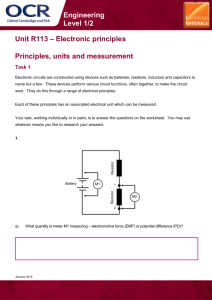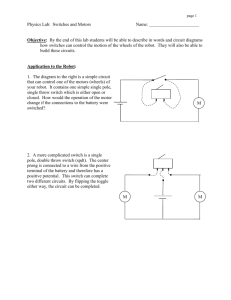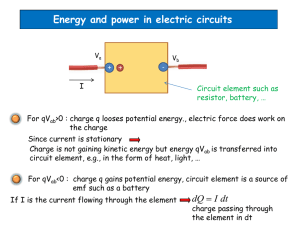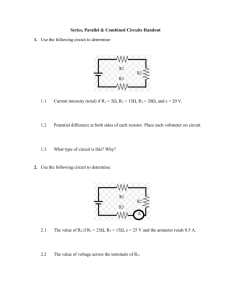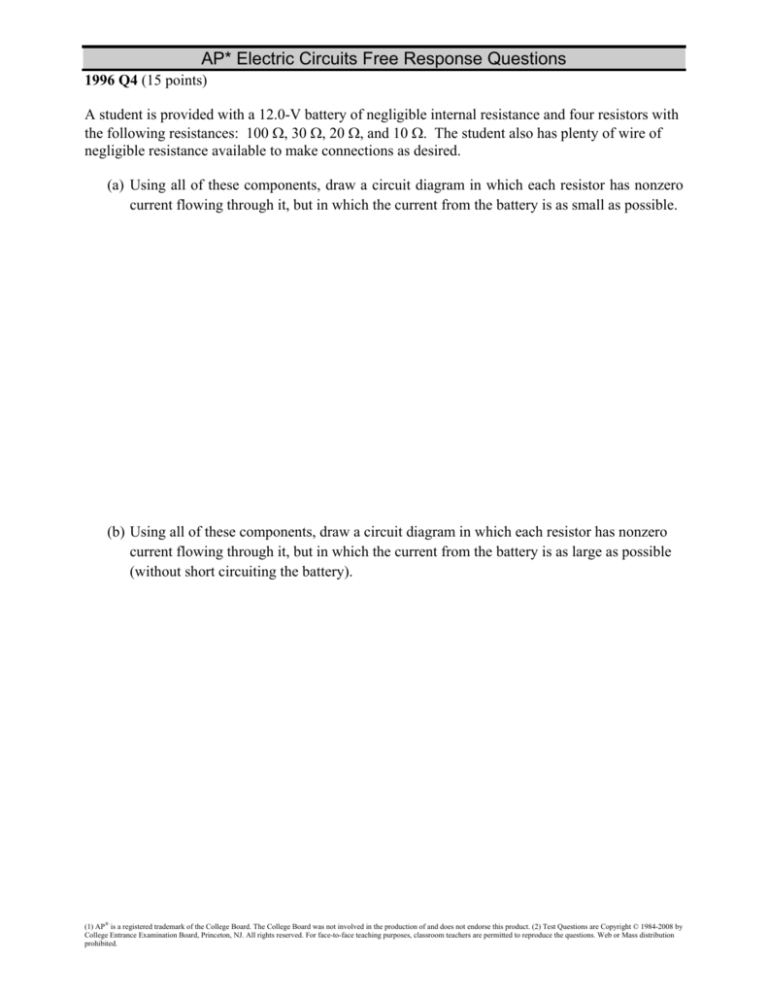
AP* Electric Circuits Free Response Questions
1996 Q4 (15 points)
A student is provided with a 12.0-V battery of negligible internal resistance and four resistors with
the following resistances: 100 Ω, 30 Ω, 20 Ω, and 10 Ω. The student also has plenty of wire of
negligible resistance available to make connections as desired.
(a) Using all of these components, draw a circuit diagram in which each resistor has nonzero
current flowing through it, but in which the current from the battery is as small as possible.
(b) Using all of these components, draw a circuit diagram in which each resistor has nonzero
current flowing through it, but in which the current from the battery is as large as possible
(without short circuiting the battery).
(1) AP® is a registered trademark of the College Board. The College Board was not involved in the production of and does not endorse this product. (2) Test Questions are Copyright © 1984-2008 by
College Entrance Examination Board, Princeton, NJ. All rights reserved. For face-to-face teaching purposes, classroom teachers are permitted to reproduce the questions. Web or Mass distribution
prohibited.
AP* Electric Circuits Free Response Questions
page 2
The battery and resistors are now connected in the circuit shown above.
(c) Determine the following for this circuit.
i.
The current in the 10-Ω resistor
ii.
The total power consumption of the circuit
(d) Assuming that the current remains constant, how long will it take to provide a total of 10 kJ
of electrical energy to the circuit?
AP* Electric Circuits Free Response Questions
page 3
2002 Q3 (15 points)
Two light bulbs, one rated 30 W at 120 V and another rated 40 W at 120 V, are arranged in two
different circuits.
(a) The two bulbs are first connected in parallel to a 120 V source.
i.
Determine the resistance of the bulb rated 30 W and the current in it when it
is connected in this circuit.
ii.
Determine the resistance of the bulb rated 40 W and the current in it when it
is connected in this circuit.
(b) The bulbs are now connected in series with each other and a 120 V source.
i. Determine the resistance of the bulb rated 30 W and the current in it when it is
connected in this circuit.
ii.
Determine the resistance of the bulb rated 40 W and the current in it when it is
connected in this circuit.
AP* Electric Circuits Free Response Questions
page 4
(c) In the spaces below, number the bulbs in each situation described, in order of their
brightness.
(1= brightest, 4 = dimmest)
__ 30 W bulb in the parallel circuit
__ 40 W bulb in the parallel circuit
__ 30 W bulb in the series circuit
__ 40 W bulb in the series circuit
(d) Calculate the total power dissipated by the two bulbs in each of the following cases.
i. The parallel circuit
ii. The series circuit
AP* Electric Circuits Free Response Questions
page 5
1998 Q4 (10 points)
In the circuit shown above, A, B. C, and D are identical light bulbs. Assume that the battery
maintains a constant potential difference between its terminals (i.e., the internal resistance of the
battery is assumed to be negligible) and the resistance of each light bulb remains constant.
(a) Draw a diagram of the circuit in the box below, using the following symbols to represent
the components in your diagram. Label the resistors A, B. C, and D to refer to the
corresponding light bulbs.
AP* Electric Circuits Free Response Questions
page 6
(b) List the bulbs in order of their brightnesses, from brightest to least bright. If any two or
more bulbs have the same brightness, state which ones. Justify your answer.
(c) Bulb D is then removed from its socket.
i. Describe the change in the brightness, if any, of bulb A when bulb D is removed
from its socket. Justify your answer.
ii.
Describe the change in the brightness, if any, of bulb B when bulb D is removed
from its socket. Justify your answer.
AP* Electric Circuits Free Response Questions
page 7
1980 Q2
D
The electrical device whose symbol is shown above requires a terminal voltage of 12 volts and a
current of 2 amperes for proper operation.
a. Using only this device and one or more 3-ohm resistors design a circuit so that the device
will operate properly when the circuit is connected across a battery of emf 24 volts and
negligible internal resistance. Within the dashed-line box in the diagram below, draw the
circuit using the symbol for the device and the appropriate symbol for each 3-ohm resistor.
b. Using only this device and one or more 3-ohm resistors, design a circuit so that the device
will operate properly when connected to a source that supplies a fixed current of 6 amperes.
Within the dashed-line box in the diagram below, draw the circuit using the symbol for the
device and the appropriate symbol.
AP* Electric Circuits Free Response Questions
page 8
c. Calculate the power dissipation in each 3-ohm resistor used in the circuit in part (b).
AP* Electric Circuits Free Response Questions
page 9
1982 Q4
A cabin contains only two small electrical appliances: a radio that requires 10 milliamperes of
current at 9 volts, and a clock that requires 20 milliamperes at 15 volts. A 15-volt battery with
negligible internal resistance supplies the electrical energy to operate the radio and the clock.
(a) Complete the diagram below to show how the radio, the clock, and a single resistor R can
be connected between points A and B so that the correct potential difference is applied
across each appliance. Use the symbols in the diagram above to indicate the radio and the
clock.
AP* Electric Circuits Free Response Questions
page 10
(b) Calculate the resistance of R.
(c) Calculate the electrical energy that must be supplied by the battery to operate the circuits
for 1 minute.
AP* Electric Circuits Free Response Questions
page 11
1983 Q3
12Ω
The circuit shown above is constructed with two batteries and three resistors. The connecting
wires may be considered to have negligible resistance. The current I is 2 amperes.
(a) Calculate the resistance R.
(b) Calculate the current in the
i.
6-ohm resistor
ii.
12-ohm resistor
AP* Electric Circuits Free Response Questions
page 12
(c) The potential at point X is 0 volts. Calculate the electric potential at points B. C, and D in
the circuit.
(d) Calculate the power supplied by the 20-volt battery.
AP* Electric Circuits Free Response Questions
page 13
1990 Q3
A battery with an emf of 24 volts and an internal resistance of I ohm is connected to an external
circuit as shown above. Determine each of the following:
(a) the equivalent resistance of the combination of the 4-ohm, 8-ohm, and 12-ohm resistors
(b) the current in the 5-ohm resistor
(c) the terminal voltage, VAC of the battery
AP* Electric Circuits Free Response Questions
(d) the rate at which energy is dissipated in the 12-ohm resistor
(e) the magnitude of the potential difference VBC
(f) the power delivered by the battery to the external circuit
page 14
AP* Electric Circuits Free Response Questions
page 15
1987 Q4
Three resistors are arranged in a circuit as shown above. The battery has an unknown but constant
emf ε and a negligible internal resistance.
(a) Determine the equivalent resistance of the three resistors.
The current I in resistor R3 is 0.40 ampere.
(b) Determine the emf ε (Voltage) of the battery.
AP* Electric Circuits Free Response Questions
page 16
(c) Determine the potential difference across resistor R1
(d) Determine the power dissipated in resistor R1
(e) Determine the amount of charge that passes through resistor R3 in one minute.
AP* Electric Circuits Free Response Questions
page 17
1981 Q4
A circuit consists of battery A of emf εA = 60 volts and Internal resistance rA = 3 ohms; battery B
of emf εB = 12 volts and internal resistance rB = 1 ohm; and four resistors connected as shown in
the diagram above.
(a) Calculate the current in the 2-ohm resistor.
(b) Calculate the power dissipated in the 3-ohm resistor.
(c) Calculate the terminal voltage of battery B.
AP* Electric Circuits Free Response Questions
page 18
1989 Q3
A series circuit consists of a battery of negligible internal resistance, a variable resistor, and an
electric motor of negligible resistance. The current in the circuit is 2 amperes when the resistance
in the circuit is adjusted to 10 ohms. Under these conditions the motor lifts a l-kilogram mass
vertically at a constant speed of 2 meters per second.
(a) Determine the electrical power that is
i.
dissipated in the resistor
ii.
used by the motor in lifting the mass
iii.
supplied by the battery
(b) Determine the potential difference across
i.
the resistor
ii.
the motor
iii.
the battery
AP* Electric Circuits Free Response Questions
page 19
The resistor is now adjusted until the mass rises vertically at a constant speed of 3 meters per
second. The voltage drop across the motor is proportional to the speed of the motor, and the
current remains constant.
(c) Determine the voltage drop across the motor.
(d) Determine the new resistance in the circuit.
AP* Electric Circuits Free Response Questions
page 20
1991 Q4
A battery with emf ε and internal resistance r is connected to a variable resistance R at points X
and Y. as shown above on the left. Varying R changes both the current I and the terminal voltage
VXY. The quantities I and VXY are measured for several values of R and the data are plotted in a
graph, as shown above on the right.
(a) Determine the emf ε of the battery.
(b) Determine the internal resistance r of the battery.
AP* Electric Circuits Free Response Questions
page 21
(c) Determine the value of the resistance R that will produce a current I of 3 amperes.
(d) Determine the maximum current that the battery can produce.
(e) The current and voltage measurements were made with an ammeter and a voltmeter. On
the diagram below, show a proper circuit for performing these
V
measurements. Use
A
to represent the ammeter and to represent the voltmeter.
AP* Electric Circuits Free Response Questions
page 22
2001 Q5 (10 points)
A platinum resistor has a resistance that changes with temperature. Values of the
resistance were obtained experimentally for several temperatures from 5°C to 30°C only
and plotted on the graph above. Design a procedure in which this resistor can be used as a
thermometer to measure the temperature of a liquid that is in the 50°C to 75°C range. The
resistor can be safely immersed in liquids. Along with the resistor and the container of the
liquid of unknown temperature, the following equipment and materials may be used.
Power supply
Ammeter
(Note: The ammeter and the voltmeter
cannot
Voltmeter
be used directly as an ohmmeter.)
Connecting wires
Ice-water bath
Boiling-water bath
(a) Sketch a diagram (with labels) to show how equipment is to be connected to make
the necessary measurements, and briefly outline the steps to be followed.
AP* Electric Circuits Free Response Questions
page 23
(b) Discuss what measurements will be taken to determine the temperature of the
unknown liquid.
(c) Discuss one assumption that must be made regarding equipment or procedure in order to use
the method you have described.
AP* Electric Circuits Free Response Questions
page 24
1988 Q3
The circuit shown above includes a switch S, which can be closed to connect the 3-microfarad
capacitor in parallel with the 10-ohm resistor or opened to disconnect the capacitor from the
circuit.
Case 1: Switch S is open. The capacitor is not connected. Under these conditions determine:
(a) the current in the battery
(b) the current in the 10-ohm resistor
(c) the potential difference across the 10-ohm resistor
AP* Electric Circuits Free Response Questions
page 25
Case II: Switch S is closed. The capacitor is connected. After some time, the currents reach
constant values. Under these conditions determine:
(d) the charge on the capacitor
(e) the energy stored in the capacitor
AP* Electric Circuits Free Response Questions
page 26
2003 Q2 (15 points)
A circuit contains two resistors (10 Ω and 20 Ω) and two capacitors (12 μF and 6 μF) connected to
a 6 V battery, as shown in the diagram above. The circuit has been connected for a long time.
(a) Calculate the total capacitance of the circuit.
(b) Calculate the current in the 10 Ω resistor.
(c) Calculate the potential difference between points A and B.
AP* Electric Circuits Free Response Questions
page 27
(d) Calculate the charge stored on one plate of the 6 μF capacitor.
(e) The wire is cut at point P. Will the potential difference between points A and B increase,
decrease, or remain the same?
____ increase ____ decrease ____ remain the same
Justify your answer.





